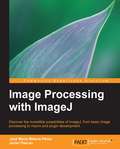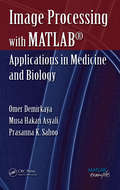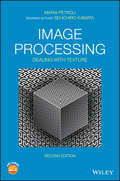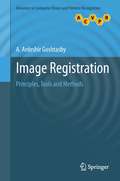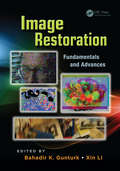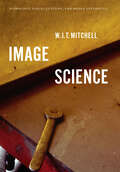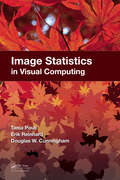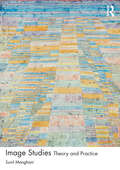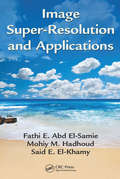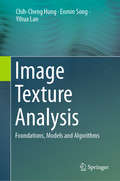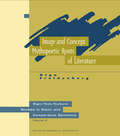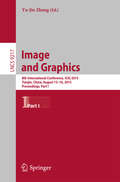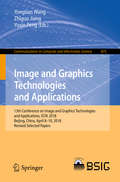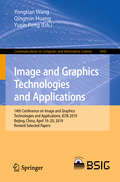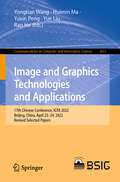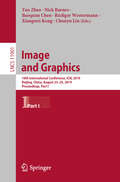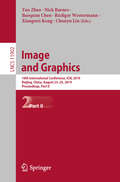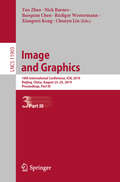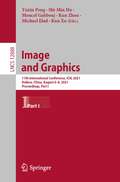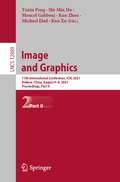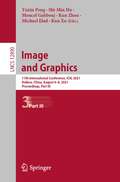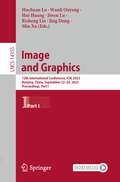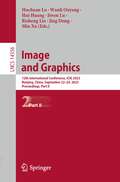- Table View
- List View
Image Processing with ImageJ
by Javier Pascau Jose Maria Mateos-PerezThe book will help readers discover the various facilities of ImageJ through a tutorial-based approach.This book is targeted at scientists, engineers, technicians, and managers, and anyone who wishes to master ImageJ for image viewing, processing, and analysis. If you are a developer, you will be able to code your own routines after you have finished reading this book. No prior knowledge of ImageJ is expected.
Image Processing with MATLAB: Applications in Medicine and Biology
by Omer Demirkaya Musa H. Asyali Prasanna K. SahooImage Processing with MATLAB: Applications in Medicine and Biology explains complex, theory-laden topics in image processing through examples and MATLAB algorithms. It describes classical as well emerging areas in image processing and analysis. Providing many unique MATLAB codes and functions throughout, the book covers the theory of probability an
Image Processing: Dealing with Texture
by Maria M. Petrou Sei-ichiro KamataThe classic text that covers practical image processing methods and theory for image texture analysis, updated second edition The revised second edition of Image Processing: Dealing with Textures updates the classic work on texture analysis theory and methods without abandoning the foundational essentials of this landmark work. Like the first, the new edition offers an analysis of texture in digital images that are essential to a diverse range of applications such as: robotics, defense, medicine and the geo-sciences. Designed to easily locate information on specific problems, the text is structured around a series of helpful questions and answers. Updated to include the most recent developments in the field, many chapters have been completely revised including: Fractals and Multifractals, Image Statistics, Texture Repair, Local Phase Features, Dual Tree Complex Wavelet Transform, Ridgelets and Curvelets and Deep Texture Features. The book takes a two-level mathematical approach: light math is covered in the main level of the book, with harder math identified in separate boxes. This important text: Contains an update of the classic advanced text that reviews practical image processing methods and theory for image texture analysis Puts the focus exclusively on an in-depth exploration of texture Contains a companion website with exercises and algorithms Includes examples that are fully worked to enhance the learning experience Written for students and researchers of image processing, the second edition of Image Processing has been revised and updated to incorporate the foundational information on the topic and information on the latest advances.
Image Registration
by A. Ardeshir GoshtasbyThis book presents a thorough and detailed guide to image registration, outlining the principles and reviewing state-of-the-art tools and methods. The book begins by identifying the components of a general image registration system, and then describes the design of each component using various image analysis tools. The text reviews a vast array of tools and methods, not only describing the principles behind each tool and method, but also measuring and comparing their performances using synthetic and real data. Features: discusses similarity/dissimilarity measures, point detectors, feature extraction/selection and homogeneous/heterogeneous descriptors; examines robust estimators, point pattern matching algorithms, transformation functions, and image resampling and blending; covers principal axes methods, hierarchical methods, optimization-based methods, edge-based methods, model-based methods, and adaptive methods; includes a glossary, an extensive list of references, and an appendix on PCA.
Image Restoration: Fundamentals and Advances (Digital Imaging and Computer Vision #7)
by Xin Li Bahadir K. GunturkImage Restoration: Fundamentals and Advances responds to the need to update most existing references on the subject, many of which were published decades ago. Providing a broad overview of image restoration, this book explores breakthroughs in related algorithm development and their role in supporting real-world applications associated with various scientific and engineering fields. These include astronomical imaging, photo editing, and medical imaging, to name just a few. The book examines how such advances can also lead to novel insights into the fundamental properties of image sources. Addressing the many advances in imaging, computing, and communications technologies, this reference strikes just the right balance of coverage between core fundamental principles and the latest developments in this area. Its content was designed based on the idea that the reproducibility of published works on algorithms makes it easier for researchers to build on each other’s work, which often benefits the vitality of the technical community as a whole. For that reason, this book is as experimentally reproducible as possible. Topics covered include: Image denoising and deblurring Different image restoration methods and recent advances such as nonlocality and sparsity Blind restoration under space-varying blur Super-resolution restoration Learning-based methods Multi-spectral and color image restoration New possibilities using hybrid imaging systems Many existing references are scattered throughout the literature, and there is a significant gap between the cutting edge in image restoration and what we can learn from standard image processing textbooks. To fill that need but avoid a rehash of the many fine existing books on this subject, this reference focuses on algorithms rather than theories or applications. Giving readers access to a large amount of downloadable source code, the book illustrates fundamental techniques, key ideas developed over the years, and the state of the art in image restoration. It is a valuable resource for readers at all levels of understanding.
Image Science: Iconology, Visual Culture, and Media Aesthetics
by W.J.T. MitchellAlmost thirty years ago, W. J. T. Mitchell's Iconology helped launch the interdisciplinary study of visual media, now a central feature of the humanities. Along with his subsequent Picture Theory and What Do Pictures Want?, Mitchell's now-classic work introduced such ideas as the pictorial turn, the image/picture distinction, the metapicture, and the biopicture. These key concepts imply an approach to images as true objects of investigation--an "image science. " Continuing with this influential line of thought, Image Science gathers Mitchell's most recent essays on media aesthetics, visual culture, and artistic symbolism. The chapters delve into such topics as the physics and biology of images, digital photography and realism, architecture and new media, and the occupation of space in contemporary popular uprisings. The book looks both backward at the emergence of iconology as a field and forward toward what might be possible if image science can indeed approach pictures the same way that empirical sciences approach natural phenomena. Essential for those involved with any aspect of visual media, Image Science is a brilliant call for a method of studying images that overcomes the "two-culture split" between the natural and human sciences.
Image Statistics in Visual Computing
by Tania Pouli Erik Reinhard Douglas W. CunninghamTo achieve the complex task of interpreting what we see, our brains rely on statistical regularities and patterns in visual data. Knowledge of these regularities can also be considerably useful in visual computing disciplines, such as computer vision, computer graphics, and image processing. The field of natural image statistics studies the regular
Image Studies: Theory and Practice
by Sunil ManghaniImage Studies offers an engaging introduction to visual and image studies. In order to better understand images and visual culture the book seeks to bridge between theory and practice; asking the reader to think critically about images and image practices, but also simultaneously to make images and engage with image-makers and image-making processes. Looking across a range of domains and disciplines, we find the image is never a single, static thing. Rather, the image can be a concept, an object, a picture, or medium – and all these things combined. At the heart of this book is the idea of an ‘ecology of images’, through which we can examine the full ‘life’ of an image – to understand how an image resonates within a complex set of contexts, processes and uses. Part 1 covers theoretical perspectives on the image, supplemented with practical entries on making, researching and writing with images. Part 2 explores specific image practices and cultures, with chapters on drawing and painting; photography; visual culture; scientific imaging; and informational images. A wide range of illustrations complement the text throughout and each chapter includes creative tasks, keywords (linked to an online resource), summaries and suggested further reading. In addition, each of the main chapters include selected readings by notable authors across a range of subject areas, including: Art History, Business, Cognitive Science, Communication Studies, Infographics, Neuroscience, Photography, Physics, Science Studies, Social Semiotics, Statistics, and Visual Culture.
Image Super-Resolution and Applications
by Fathi E. El-Samie Mohiy M. Hadhoud Said E. El-KhamyThis book is devoted to the issue of image super-resolution-obtaining high-resolution images from single or multiple low-resolution images. Although there are numerous algorithms available for image interpolation and super-resolution, there's been a need for a book that establishes a common thread between the two processes. Filling this need, Image
Image Texture Analysis: Foundations, Models and Algorithms
by Chih-Cheng Hung Enmin Song Yihua LanThis useful textbook/reference presents an accessible primer on the fundamentals of image texture analysis, as well as an introduction to the K-views model for extracting and classifying image textures. Divided into three parts, the book opens with a review of existing models and algorithms for image texture analysis, before delving into the details of the K-views model. The work then concludes with a discussion of popular deep learning methods for image texture analysis.Topics and features: provides self-test exercises in every chapter; describes the basics of image texture, texture features, and image texture classification and segmentation; examines a selection of widely-used methods for measuring and extracting texture features, and various algorithms for texture classification; explains the concepts of dimensionality reduction and sparse representation; discusses view-based approaches to classifying images; introduces the template for the K-views algorithm, as well as a range of variants of this algorithm; reviews several neural network models for deep machine learning, and presents a specific focus on convolutional neural networks.This introductory text on image texture analysis is ideally suitable for senior undergraduate and first-year graduate students of computer science, who will benefit from the numerous clarifying examples provided throughout the work.
Image and Concept: Mythopoetic Roots of Literature
by Olga FreidenbergFirst published in 1997. Routledge is an imprint of Taylor & Francis, an informa company.
Image and Graphics
by Yu-Jin ZhangThis book constitutes the refereed conference proceedings of the 8th International Conference on Image and Graphics, ICIG 2015 held in Tianjin, China, in August 2015. The 164 revised full papers and 6 special issue papers were carefully reviewed and selected from 339 submissions. The papers focus on various advances of theory, techniques and algorithms in the fields of images and graphics.
Image and Graphics Technologies and Applications: 13th Conference On Image And Graphics Technologies And Applications, Igta 2018, Beijing, China, April 8-10, 2018, Revised Selected Papers (Communications In Computer And Information Science #875)
by Yongtian Wang Zhiguo Jiang Yuxin PengThis book constitutes the refereed proceedings of the 13th Chinese Conference on Image and Graphics Technologies and Applications, IGTA 2018, held in Beijing, China in April, 2018. The 64 papers presented were carefully reviewed and selected from 138 submissions. They provide a forum for sharing progresses in the areas of image processing technology; image analysis and understanding; computer vision and pattern recognition; big data mining, computer graphics and VR; as well as image technology applications.
Image and Graphics Technologies and Applications: 14th Conference on Image and Graphics Technologies and Applications, IGTA 2019, Beijing, China, April 19–20, 2019, Revised Selected Papers (Communications in Computer and Information Science #1043)
by Yongtian Wang Yuxin Peng Qingmin HuangThis book constitutes the refereed proceedings of the 14th Conference on Image and Graphics Technologies and Applications, IGTA 2019, held in Beijing, China in April, 2019. The 66 papers presented were carefully reviewed and selected from 152 submissions. They provide a forum for sharing progresses in the areas of image processing technology; image analysis and understanding; computer vision and pattern recognition; big data mining, computer graphics and VR, as well as image technology applications.
Image and Graphics Technologies and Applications: 15th Chinese Conference, IGTA 2020, Beijing, China, September 19, 2020, Revised Selected Papers (Communications in Computer and Information Science #1314)
by Yongtian Wang Yuxin Peng Xueming LiThis book constitutes the refereed proceedings of the 15th Conference on Image and Graphics Technologies and Applications, IGTA 2020, held in Beijing, China in September, 2020.*The 24 papers presented were carefully reviewed and selected from 115 submissions. They provide a forum for sharing progresses in the areas of image processing technology; image analysis and understanding; computer vision and pattern recognition; big data mining, computer graphics and VR, as well as image technology applications. *The conference was held virtually due to the COVID-19 pandemic.
Image and Graphics Technologies and Applications: 16th Chinese Conference on Image and Graphics Technologies, IGTA 2021, Beijing, China, June 6–7, 2021, Revised Selected Papers (Communications in Computer and Information Science #1480)
by Yongtian Wang Weitao SongThis book constitutes the refereed proceedings of the 16th Conference on Image and Graphics Technologies and Applications, IGTA 2021, held in Beijing, China in June, 2021. The 21 papers presented were carefully reviewed and selected from 86 submissions. They provide a forum for sharing progresses in the areas of image processing technology; image analysis and understanding; computer vision and pattern recognition; big data mining, computer graphics and VR, as well as image technology applications. The volume contains the following thematic blocks: image processing and enhancement techniques (image information acquisition, image/video coding, image/video transmission, image/video storage, compression, completion, dehazing, reconstruction and display, etc.); biometric identification techniques (biometric identification and authentication techniques including face, fingerprint, iris and palm-print, etc.); machine vision and 3D reconstruction (visual information acquisition, camera calibration, stereo vision, 3D reconstruction, and applications of machine vision in industrial inspection, etc.); image/video big data analysis and understanding (object detection and recognition, image/video retrieval, image segmentation, matching, analysis and understanding); computer graphics (modeling, rendering, algorithm simplification and acceleration techniques, realistic scene generation, 3D reconstruction algorithm, system and application, etc.); virtual reality and human-computer interaction (virtual scene generation techniques, tracing and positioning techniques for large-scale space, augmented reality techniques, human-computer interaction techniques based on computer vision, etc.); applications of image and graphics (image/video processing and transmission, biomedical engineering applications, information security, digital watermarking, text processing and transmission, remote sensing, telemetering, etc.); other research works and surveys related to the applications of image and graphics technology.
Image and Graphics Technologies and Applications: 17th Chinese Conference, IGTA 2022, Beijing, China, April 23–24, 2022, Revised Selected Papers (Communications in Computer and Information Science #1611)
by Ran He Yue Liu Yongtian Wang Yuxin Peng Huimin MaThis book constitutes the refereed proceedings of the 17th Chinese Conference on Image and Graphics Technologies and Applications, IGTA 2022, held in Beijing, China, during April 23–24, 2022.The 25 full papers included in this book were carefully reviewed and selected from 77 submissions. They were organized in topical sections as follows: image processing and enhancement techniques; machine vision and 3D reconstruction; image/Video big data analysis and understanding; computer graphics; visualization and visual analysis; applications of image and graphics.
Image and Graphics: 10th International Conference, ICIG 2019, Beijing, China, August 23–25, 2019, Proceedings, Part I (Lecture Notes in Computer Science #11901)
by Yao Zhao Xiangwei Kong Nick Barnes Baoquan Chen Rüdiger Westermann Chunyu LinThis three-volume set LNCS 11901, 11902, and 11903 constitutes the refereed conference proceedings of the 10thth International Conference on Image and Graphics, ICIG 2019, held in Beijing, China, in August 2019. The 183 full papers presented were selected from 384 submissions and focus on advances of theory, techniques and algorithms as well as innovative technologies of image, video and graphics processing and fostering innovation, entrepreneurship, and networking.
Image and Graphics: 10th International Conference, ICIG 2019, Beijing, China, August 23–25, 2019, Proceedings, Part II (Lecture Notes in Computer Science #11902)
by Yao Zhao Xiangwei Kong Nick Barnes Baoquan Chen Rüdiger Westermann Chunyu LinThis three-volume set LNCS 11901, 11902, and 11903 constitutes the refereed conference proceedings of the 10thth International Conference on Image and Graphics, ICIG 2019, held in Beijing, China, in August 2019. The 183 full papers presented were selected from 384 submissions and focus on advances of theory, techniques and algorithms as well as innovative technologies of image, video and graphics processing and fostering innovation, entrepreneurship, and networking.
Image and Graphics: 10th International Conference, ICIG 2019, Beijing, China, August 23–25, 2019, Proceedings, Part III (Lecture Notes in Computer Science #11903)
by Yao Zhao Xiangwei Kong Nick Barnes Baoquan Chen Rüdiger Westermann Chunyu LinThis three-volume set LNCS 11901, 11902, and 11903 constitutes the refereed conference proceedings of the 10thth International Conference on Image and Graphics, ICIG 2019, held in Beijing, China, in August 2019. The 183 full papers presented were selected from 384 submissions and focus on advances of theory, techniques and algorithms as well as innovative technologies of image, video and graphics processing and fostering innovation, entrepreneurship, and networking.
Image and Graphics: 11th International Conference, ICIG 2021, Haikou, China, August 6–8, 2021, Proceedings, Part I (Lecture Notes in Computer Science #12888)
by Moncef Gabbouj Shi-Min Hu Yuxin Peng Kun Zhou Kun Xu Michael EladThis three-volume set LNCS 12888, 12898, and 12890 constitutes the refereed conference proceedings of the 11th International Conference on Image and Graphics, ICIG 2021, held in Haikou, China, in August 2021.* The 198 full papers presented were selected from 421 submissions and focus on advances of theory, techniques and algorithms as well as innovative technologies of image, video and graphics processing and fostering innovation, entrepreneurship, and networking. *The conference was postponed due to the COVID-19 pandemic.
Image and Graphics: 11th International Conference, ICIG 2021, Haikou, China, August 6–8, 2021, Proceedings, Part II (Lecture Notes in Computer Science #12889)
by Moncef Gabbouj Shi-Min Hu Yuxin Peng Kun Zhou Kun Xu Michael EladThis three-volume set LNCS 12888, 12898, and 12890 constitutes the refereed conference proceedings of the 11th International Conference on Image and Graphics, ICIG 2021, held in Haikou, China, in August 2021.* The 198 full papers presented were selected from 421 submissions and focus on advances of theory, techniques and algorithms as well as innovative technologies of image, video and graphics processing and fostering innovation, entrepreneurship, and networking. *The conference was postponed due to the COVID-19 pandemic.
Image and Graphics: 11th International Conference, ICIG 2021, Haikou, China, August 6–8, 2021, Proceedings, Part III (Lecture Notes in Computer Science #12890)
by Moncef Gabbouj Shi-Min Hu Yuxin Peng Kun Zhou Kun Xu Michael EladThis three-volume set LNCS 12888, 12898, and 12890 constitutes the refereed conference proceedings of the 11th International Conference on Image and Graphics, ICIG 2021, held in Haikou, China, in August 2021.* The 198 full papers presented were selected from 421 submissions and focus on advances of theory, techniques and algorithms as well as innovative technologies of image, video and graphics processing and fostering innovation, entrepreneurship, and networking. *The conference was postponed due to the COVID-19 pandemic.
Image and Graphics: 12th International Conference, ICIG 2023, Nanjing, China, September 22–24, 2023, Proceedings, Part I (Lecture Notes in Computer Science #14355)
by Min Xu Hui Huang Jiwen Lu Huchuan Lu Jing Dong Wanli Ouyang Risheng LiuThe five-volume set LNCS 14355, 14356, 14357, 14358 and 14359 constitutes the refereed proceedings of the 12th International Conference on Image and Graphics, ICIG 2023, held in Nanjing, China, during September 22–24, 2023.The 166 papers presented in the proceedings set were carefully reviewed and selected from 409 submissions. They were organized in topical sections as follows: computer vision and pattern recognition; computer graphics and visualization; compression, transmission, retrieval; artificial intelligence; biological and medical image processing; color and multispectral processing; computational imaging; multi-view and stereoscopic processing; multimedia security; surveillance and remote sensing, and virtual reality.The ICIG 2023 is a biennial conference that focuses on innovative technologies of image, video and graphics processing and fostering innovation, entrepreneurship, and networking. It will feature world-class plenary speakers, exhibits, and high-quality peer reviewed oral and poster presentations.
Image and Graphics: 12th International Conference, ICIG 2023, Nanjing, China, September 22–24, 2023, Proceedings, Part II (Lecture Notes in Computer Science #14356)
by Min Xu Hui Huang Jiwen Lu Huchuan Lu Jing Dong Wanli Ouyang Risheng LiuThe five-volume set LNCS 14355, 14356, 14357, 14358 and 14359 constitutes the refereed proceedings of the 12th International Conference on Image and Graphics, ICIG 2023, held in Nanjing, China, during September 22–24, 2023.The 166 papers presented in the proceedings set were carefully reviewed and selected from 409 submissions. They were organized in topical sections as follows: computer vision and pattern recognition; computer graphics and visualization; compression, transmission, retrieval; artificial intelligence; biological and medical image processing; color and multispectral processing; computational imaging; multi-view and stereoscopic processing; multimedia security; surveillance and remote sensing, and virtual reality.The ICIG 2023 is a biennial conference that focuses on innovative technologies of image, video and graphics processing and fostering innovation, entrepreneurship, and networking. It will feature world-class plenary speakers, exhibits, and high quality peer reviewed oral and poster presentations.
